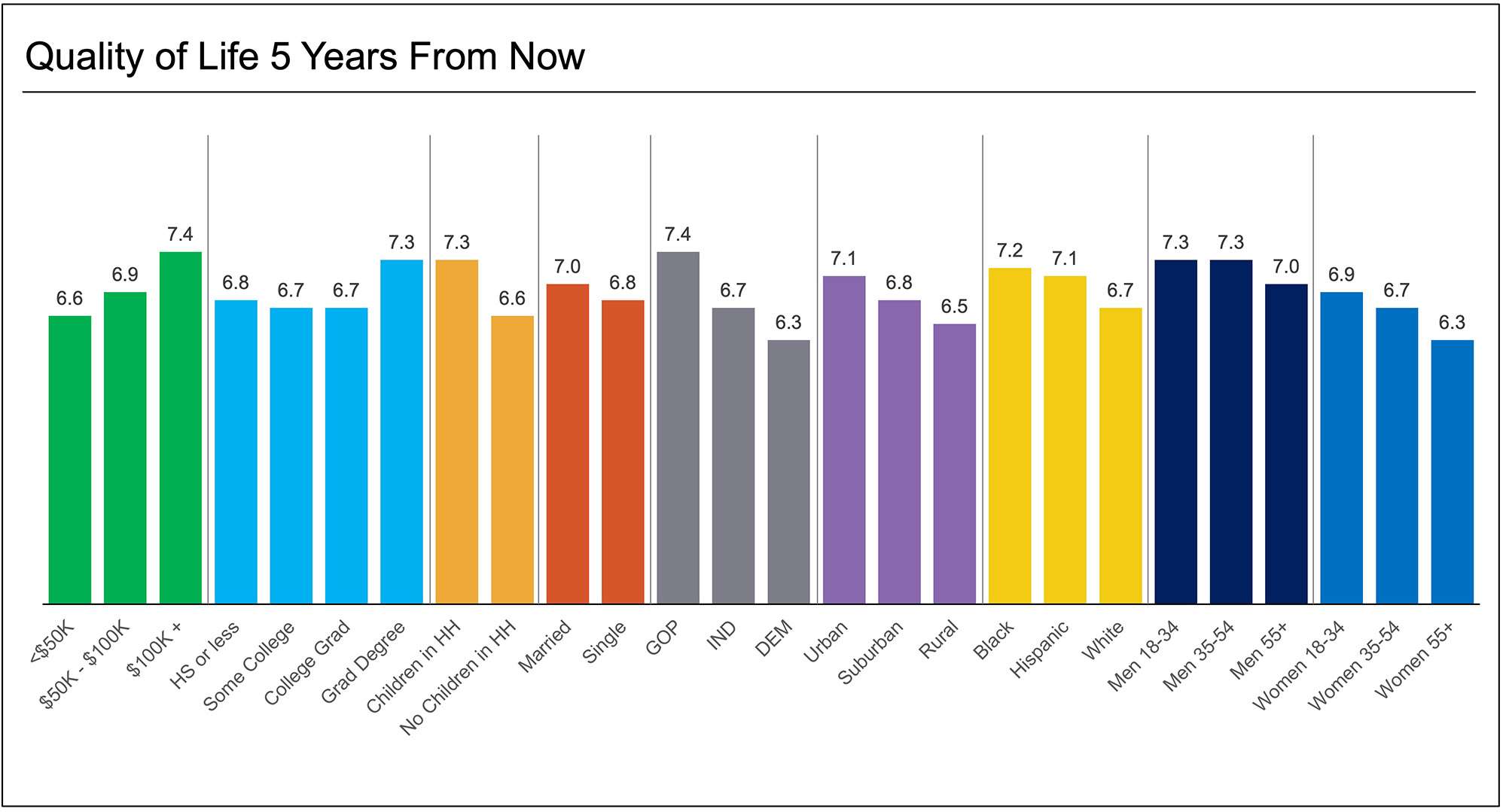By Dee Allsop, Co-CEO + Founding Partner
Key Takeaways
- Americans currently rate their quality of life in America at 6.1 out of 10—slightly lower than five years ago but with optimism for the future.
- Young adults (ages 25–34) are the most hopeful, expecting their quality of life to rise significantly over the next five years.
- Higher income earners, those with graduate degrees, and Republicans report the highest expectations for future quality of life in America.
- Black and Hispanic Americans are more optimistic about their future quality of life than White Americans.
- Urban residents and men are generally more positive about their current and future quality of life than rural residents and women.
- Parents report higher optimism about their future quality of life compared to non-parents.
- These insights help guide regional visioning efforts and deepen our understanding of what makes life meaningful in America.
A Front Row Seat to American Sentiment
Few jobs offer the privilege of exploring what truly matters to people. As someone who spends their days asking Americans about their hopes, challenges, and decisions, I’ve come to see this work as the most interesting job in the world. Through interviews, discussion groups, and public opinion studies at Heart+Mind Strategies, we uncover insights that validate what we thought we knew, reveal what we didn’t, and spark new questions that deepen our understanding.
One of the most compelling areas we explore is the quality of life in America—how people perceive it today, how they remember it in the past, and how they expect it to evolve.
Measuring the Quality of Life in America
Each year I track American sentiment relating to our quality of life. We ask Americans to imagine a 10-step ladder representing the quality of life in America where they live. The top step symbolizes the best possible life, and the bottom, the worst. We ask them to place themselves on the ladder today, five years ago, and five years into the future.
In our most recent study, Americans rated their current quality of life in America at 6.1—just above the sixth step. That’s slightly lower than five years ago (6.4), but they’re hopeful: they expect it to rise to 6.8 in the next five years. This pattern—feeling slightly worse off now but optimistic about the future—holds true across nearly every demographic.

The Optimism of Youth
There’s one standout group: young adults aged 25–34. They report a steady climb in their quality of life in America—from 6.5 five years ago to 6.6 today, and a hopeful 7.25 five years from now. This exception tells us more about our human life cycle than anything going on in our world today. Oh, to the joy and promise of youth!
Who’s Most Hopeful About the Future?
It’s also fun to look at who is most optimistic about the future. When we dig deeper, we find that optimism about the quality of life in America varies by income, education, and even political affiliation:
Yes, those with higher incomes ($100K or more report 7.4) and the most highly educated (Masters or Ph.Ds. report 7.3) are among those reporting the highest expectation for quality of life five years from now. But right at the top with them are Republicans (also at 7.4) which tells us a lot more about the impact of politics on quality of life than anything else. Who would have known that being Republican was just as good as being high income when it comes to quality of life in the Trump era? By contrast, Democrats are among the least optimistic about their quality of life five years from now.
Surprising Insights Across Demographics
There are a lot of other intriguing results that tell us there is more to feeling you have a higher quality of life than being richer or politically favored—things that tell us about the importance of different perspectives among groups of Americans and the different social circumstances that surround us.
Beyond income and politics, other factors shape how Americans view their quality of life in America:
- Parents are more optimistic than non-parents.
- Black (7.2) and Hispanic (7.1) Americans are more hopeful than White (6.7) Americans.
- Urban dwellers (7.1) are more positive than those in rural areas (6.5).
- Men (7.1) are more optimistic than women (6.6) about their future quality of life.
These findings highlight that the quality of life in America is influenced by more than just money or politics—it’s shaped by family, community, identity, and lived experience.

Why It Matters
Understanding how people perceive the quality of life and what threatens or makes the quality of life great in a particular region in America helps us guide regional visioning efforts like Imagine Nashville and Our Spacious Skies. But these insights don’t just inform policy—they help us understand what it means to live a meaningful life in America today.
And just as much, they also beg more questions for us to answer and to dig deeper to understand what it means to be human—more things to study and understand. And that’s what makes my area of work the most interesting job in the world.
Let’s Keep the Conversation Going
Curious about what’s shaping the quality of life in America—and how your community compares? We’d love to share more insights, explore your questions, or collaborate on your next visioning effort. Connect with us and let’s start a conversation that matters.
Survey Methodology: The survey consisted of 1,000 online interviews conducted April 1-11, 2025. Respondents for this survey were selected from among those who have volunteered to participate in online surveys and polls.
The data (approximately 1000 respondents) is gathered from of one of the largest online panels, which attempts to approximate a cross-section of the US population. To ensure representation of a wide variety of demographic groups we impose quotas by age, gender, and ethnicity based on US Census data for people aged 18 and older.
